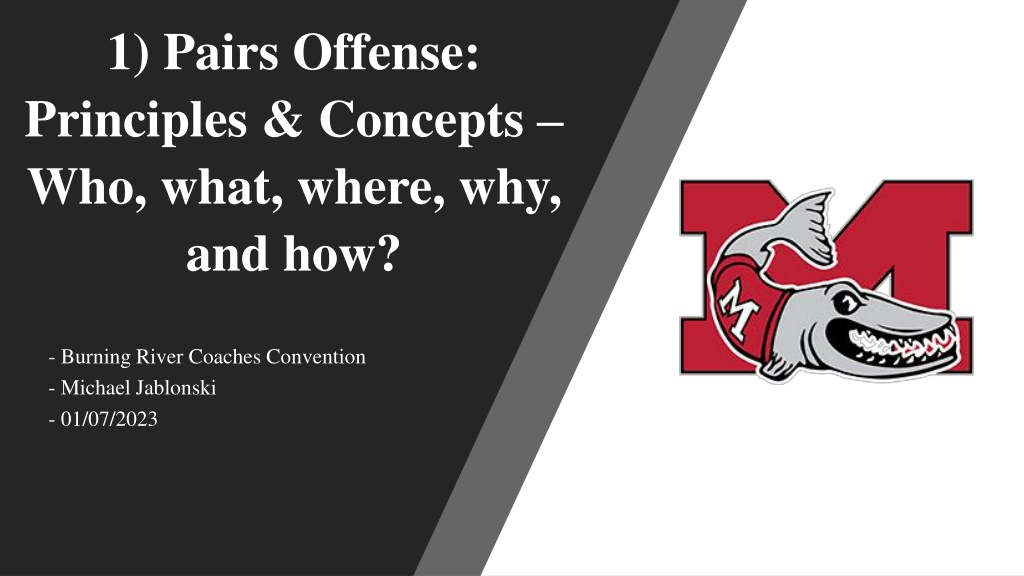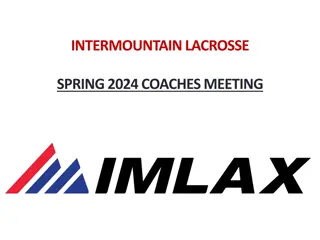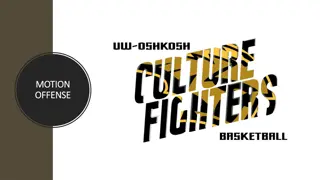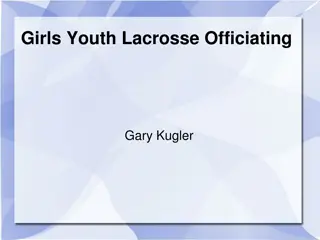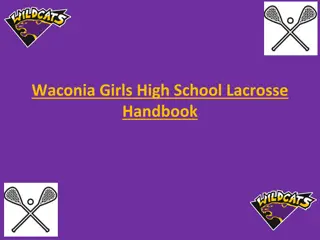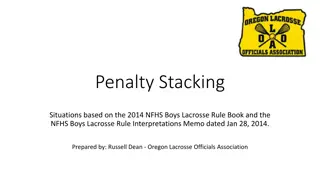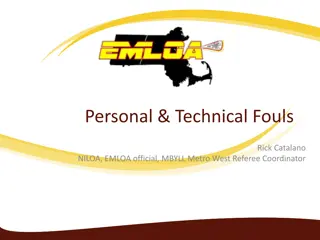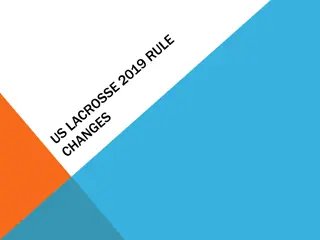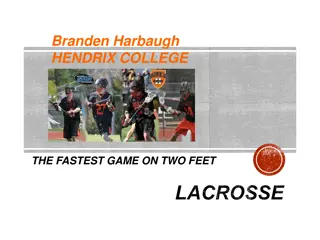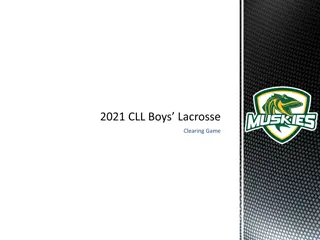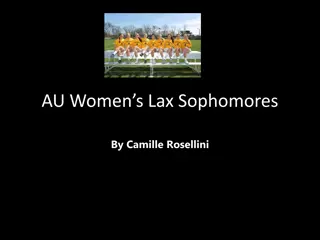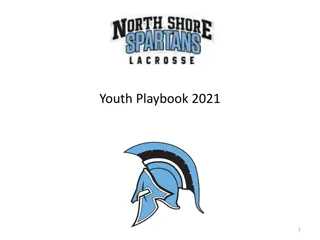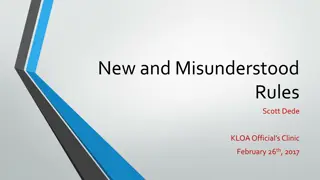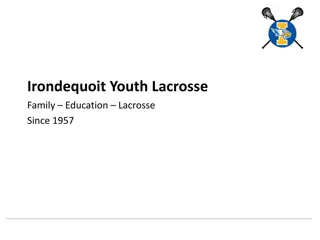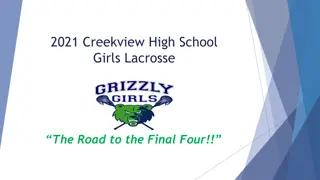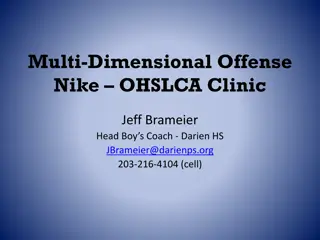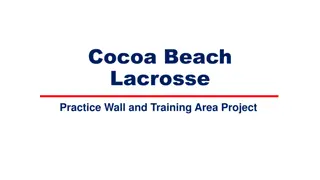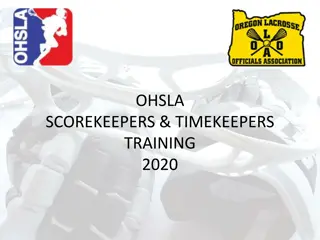Understanding Pairs Offense Principles & Concepts in Lacrosse
Delve into the core principles and concepts of pairs offense in lacrosse, exploring the benefits, challenges, and key resources for coaches. Learn how this system enhances player chemistry, offers opportunities for diverse skill sets, and prepares athletes for success at all levels.
Download Presentation

Please find below an Image/Link to download the presentation.
The content on the website is provided AS IS for your information and personal use only. It may not be sold, licensed, or shared on other websites without obtaining consent from the author. Download presentation by click this link. If you encounter any issues during the download, it is possible that the publisher has removed the file from their server.
E N D
Presentation Transcript
1) Pairs Offense: Principles & Concepts Who, what, where, why, and how? - Burning River Coaches Convention - Michael Jablonski - 01/07/2023
2) Acknowledgements Coach C for passing up the opportunity to present and allowing me to. Coach Roda & Lutz with LCHS, Coach Brubaker with 313 Lacrosse, and Coach Greaney with PLG. My parents, former teammates, and players.
3) Resources JM3 Jamie Munro is the best resource for coaches both experienced & beginner. Some slightly radical ideas but for the most part is gold. Podcasts are essential. Best of the best coaches. https://www.youtube.com/@jm3sports Joe Keegan PLL Stats. He s done a bulk of the research on the benefits of pairs, sticks to the middle, etc. https://twitter.com/joekeegs Chris Wojcik & Ryder Garnsey: IMCLA Pick video. Maybe the best one stop shop for an really good overview of pick play. https://coachesinsider.com/lacrosse/2-man-game-menu-within-your- offense-with-ryder-garnsey-chris-wojcik-university-of-notre-dame/ Bobby Benson & Kevin Warne: 2-man games offensively & defensively. Social Media: These accounts are a must follow Jordan Ruggeri, Peter Treppa, FirstClassLacrosse, FirstClassLacrosse Defense. Extras: 2Wolves, Strive, focus. (Skills & drills)
4) Cons Because pairs offenses are most effective when you can run them on both sides, it s great to have at least one lefty. If you don t have a lefty attackman, you can most certainly still run pairs. It just might limit some of your abilities to run certain actions on both sides. You obviously need players who can pass & catch. But don t need a team or even a starting 6 of players who are proficient ball movers. Just a few will do, but obviously the more the better. Moving picks sometimes can happen and this can be frustrating. Won t my players get doubled? That is kind of ONE of the many points to running pairs. We want to make 2 players guard 1.
5) Pros It s a fun brand of lacrosse. Kids enjoy it when they know how to do it and they get to develop chemistry in unique ways with players of the same hand. There are opportunities for kids who maybe aren t as big, fast, strong, etc. to excel in 2-man games/pairs. (Especially maybe someone with a good stick) It s being ran at obviously highest levels of lacrosse with PLL & D1, but also across the D2, D3, NAIA, and MCLA. Not just the elite teams. Almost everyone in our conference has at least one offense or more where they are setting picks. You ll be preparing your players for success at the college level by installing pairs concepts. Hard to defend even when you know it s coming.
6) Who? Anyone. You don t need a super slick group of players to run 2- man games. Basketball players, box players, read option QBS, and generally think hockey players in my experience do well too because they re used to making quick decisions in short time spans. Have ran pairs concepts with a beginners/entry level club with 586 Lacrosse. Certainly, having a balance of lefties & righties is great, and having players with good hands helps. It s not necessary, and ultimately what matters more is the where, why, and how we execute our picks/2-man game. The numbers show lefty 2-man games on the wing are the most effective.
7) What? Your menu, options, and giving your pairs offense variety. Mirrors: NO pick. Most basic form of 2 man. (Although you could say the give & go is the most basic form) Some people call this a pop. When you re positioned 4-7 yards from the dodger & you mirror the dodger s path to the opposite direction. Deep, medium, and close reasons for reach. Deep: Someone who LOVES to rollback & re-dodge a million times. We all have & know this player. Gives him time & space to make multiple moves. Close: Someone who beats their man RIGHT AWAY. We sometimes are lucky to have players like this, and when they can beat their guy right away, we want to get close & invite that defender to slide. Address with your players depth, role, and make sure they re listening & watching both the on & off ball defender. Mirroring is generally the easiest action for players to grasp. Shallow cut: A clear through/a cut through on a curved path that takes you out of the dodger s path & then curls back around to replace the dodger. Shallow mirror cut: A shallow cut that takes you to the interior, then you pop/mirror behind the dodger in the opposite direction that they went. Exchange: When 2 off ball players switch spots by shallow cutting on an arc/curl. Pick: A pick is for the ball/on ball. There are a variety of types of picks, and you could present on just types of picks. We will show video & talk more about the specific TYPE of pick in terms of direction (up, down) and location later (slam, razor).
What? Continued. Here are a few different kinds that you can do in a variety of areas/directions. Don t want to always do the same one, and we ll address when, why, and how to use each one later. Stick: Stick the pick, let the D run you over. Position yourself directly in the path of the on-ball defender. Think about falling over like a domino. Clip:Also referred to as a brush pick. Inviting the defender over the pick and clipping half of the defender s body/shoulder to set up a roll/help open you up. Slip: Open up & roll early before defender makes contact with you. Refusal: Going the other direction of the pick, and not using it. Sometimes the defense cheats/overplays picks, and it allows opportunities to refuse picks. (Also, can be referred to as rejecting the pick or denying the pick) Swing Pick: Setting up a pick to 1-way, then switching directions last second by swinging hips. Swing picks are DEADLY. Pick n Pop: Popping to shooting space post pick.Pick n Roll: Rolling to the net post pick. (We will dive into more on these & what the picker does as a whole in the why & how sections) These six are the most important, if your players have these down then you can add these next 4. If your players don t know how to set a good stick, clip a pick & roll to the cage, slip a pick early and roll: Then it s best to not move on just yet. Re-picks are great but if the first one isn t being executed properly then it won t be as effective. Bail: Abandon/bail on the pick before you even get close enough to slip it. Fly by:Acting like you re going to pick but don t and fly by. Similar to a bail but faster, don t slow down much. Bee-Sting Pick: A pick with your butt. Can work well when the dodger starts to use the pick, then halfway through they reverse field & there s no time to swivel your hips back around, so you have to just pick with your butt (Good clip of Ryan Ambler from the Archers doing it out there somewhere) Re-pick: A pick one way, and then quickly re-adjusting for pick the other direction.
What? Off Ball options. Screen: Is an off-ball pick. This is how I was taught to differentiate in basketball growing up & a lot of coaches use this as well. Some don t & will use screen interchangeably. Mumbo: Outside wing player sets screen/seal for inside player to curl/cut to the perimeter. Double Mumbo:2 mumbo s both sides. (Show BW) Pin:A top down screen/seal. Think you want to pin him down, so someone can come up. Sometimes in basketball it will be called a pin down . Screen & roll: Screen someone else s defender, and roll to the cage. Screen your own man: Screening your own man for someone else to curl/float off. (Think top down, pinning your own man. Or mumbo/flare, which is side to side, screening your own man so someone can float behind it)
8) Where? Location Wings, at X, at GLE, and inside/on the crease. The closer to the goal the better. Picking on the hashes is great. At the college level, if we pick on the wing, our 1st pick is usually out closer to the numbers, and as we move the ball, run actions simultaneous on & off ball, we can start to set the picks closer to the hashes. NOT top center/direct center of the field unless it s the 2nd or 3rd pick. This is purely based off the numbers. The data shows 2-man games on the wing are the most effective. Lastly, and maybe most importantly: OFF BALL. For on ball picks to be effective, there has to be some form of scripted or unscripted action on the backside. This can be an exchange, screenof someone else s defender, screening your own defender. (Travis clip)
9) Why 2-man game/pairs? Maybe the most compelling reasons & information lies here. Switch the match up/Get a match up. To gain leverage/separation (To open up your teammate). To open up yourself. (Slips, rolls, bails, nations) To create a feeding pocket/get hands free. To force on & off ball defenders to make a decision/communicate whether to switch, stay (Go over or under), chip, or jump the 2-man game. To attack a rushed/short approach. To pull a defender out of the slide package. To create a numbers advantage. To make 2 people guard 1. OR. To make 3 people guard 2. Maybe the most essential piece is understanding that when one person dodges & draws a slide there is a 5v4 off ball defensively. When 2 people are working together, and a 3rd defender does slide to that 2-man game, there is now a 4v3 off ball, which is easier to score than a 5v4 with one less defender to rotate. The most compelling reason: It s more efficient. You are statistically more likely to score using 2 man games, and getting shots with your sticks to the inside/middle.
10) How? This is the meat & potatoes. These are important aspects to remember/keys to success when running pairs both on & off ball. ARRIVE DETACHED: Before/as you compress, you want to try your best to detach from your defender. This is so crucial. Heard this from Brad Ross HC at NCAA D1 Bryant. Something I ve never heard from anyone other than him. As a picker you want to arrive detached. If you arrive with your defender right on your hip, he s going to be in a great position to communicate through the pick. If he s trailing a step behind, he s less likely to communicate, and will be in a worse position to chip, switch, and/or get out of the on-ball defender s way so he can get over/under the pick. Variety of ways to create separation & detach w/out the ball, and with the ball! (Hesitations, change of speed, cutting really hard to the inside then cutting back out) IMO: Less important when mirroring as opposed to picking.
Compress Need to get closer to your partner in the pair than some kids are used to Confusion by compression. Sometimes we can create indecision in the defense just by getting close to the ball carrier. We are getting close together, IN PART, to force the defense to communicate & make a decision. Switch, stay, chip, or jump/double? Getting close to encourage/invite the defense to double or briefly have two sets of eyes on one offensive player. Among the other reasons listed above.
Disguise: This is for both the ball carrier & the picker. The disguise is also referring to the set up. Disguising & setting up picks can be done in a variety of ways. o The picker s role: This is how the picker can disguise the pick. Get the inside angle, then work out. People use different terms to describe this. If it s a pass then pick scenario, faking the give & go is an all-time great way to disguise & detach pre-pick. You also might get a couple too (Maryland GW against ND, Demaio & Wisnauskaus) Pass then sprint towards the goal while showing your stick to the inside, then work back out to set the pick if the give & go isn t there. As you compress & try to detach from your own man, it s imperative that you try to get behind the on-ball s defender s head/back, and out of his line of sight. Usually this is done by cutting to the interior, and then working back out. Think of an L or V shape. This type of motion is usually done when passing to then pick or cutting to pick from the perimeter. This motion can be less exaggerated or even flat if you re already on the crease/have a player inside. That way when they re coming out to pick, they re already behind the defender, and in a great position to make a read. (Think 1-4-1) We d like to set blind picks if possible. Even better if you can get behind your own defender s back/head on the way there. This is why you see a lot of teams bringing a guy off the crease at the last second to pick below GLE. There are tons of ways to disguise & detach. Variety is a crucial piece in the puzzle. Setting different types of picks, picks that come from different areas, and different directions are all great tools to disguise a pick. Easiest disguise: The swingpick. Point & act like you re going to pick one direction, then swivel your hips at the last second to the other direction. Another favorite is bailing/slipping the 1st pick early to set up the re-pick, and if you re open great. If not, you re now definitely behind the on-ball defender s head, and if they dodger reverses field & comes back towards you Bam you re right there to re-pick, and in a great position to roll/slip to the cage if they do slip it.
Disguise: Sell that youre not going to use it The ball carrier s role: There are a few philosophies on how ball carriers can disguise the pick & set it up. It s not a one size fits all approach. Ultimately, the body type, athleticism, and the skill level of your players will determine/influence which techniques are best for each individual. (We all want to pick for our best attackman) We will teach certain techniques for certain players, but ultimately a combination & using a variety of techniques is probably the best way to achieve success. There are 3 main approaches that involve a ton of different skills, using these techniques in tandem is the best way to disguise & deceive the defense. 1) Sell that you re not going to use the pick. 2) Engage the defender s hands & eyes so maybe he doesn t see the pick coming. 3) Acting like you re going to use the pick and then refusing the pick & going the opposite direction. In terms of selling that you re not going to use it: Maybe the easiest way & easiest to teach: Dodge HARD opposite, then rollback. If you beat your man, the direction you initially go that s great. If not, at least the defender isn t staring at the pick right before it s being set. Look it off, don t stare at the picker (if you are trying to use it), look at the next guy in the passing rotation & float out like you re going to move the ball. Or simply look the other way right before you use the pick. Show non-threatening body language, stand up tall, jog downfield/upfield protecting your stick before rolling back/splitting back & turning on the jets. Throw pass fakes/sell pass pre-pick. Look like you re going to pass right back the picker as they start to detach, then look the other way the opposite direction of where the picker is coming from. Mix up where you re looking & faking. Great player to watch on this is Jeff Teat. When combined with other tools, using your voice can also briefly distract defenders. Tell the next guy in the rotation to pop out. Maybe use a non-verbal cue & signal for him to pop out as well. A of good defensemen might not fall for the bait. Just want them to take a peek. We are trying to create small advantages & just for a split-second force our defender to look AWAY from the pick. Using combinations of your eyes, stick (fakes), voice, body/feet, and changing body language are among the best. o
Disguise: Engaging the defenders hands Here are some options for engaging the defender s hands & eyes pre-pick: One of the best tools is just test out in space pre-pick so you engage the defender s hands. Split & roll is usually a favorite, but any type of combo move can work. Attach pre-pick. Dodge physically, lower the shoulder into the defender to attach. Negates his ability to throw heavy checks, hinder his ability to navigate the pick, and if the picker does his job, it s going to be really hard for that defender. At the very least, we make them detach & go far around the pick If the defender doesn t detach from the ball carrier and make an attempt to go around the pick. If he tries to fight over the pick, there s a very very strong likelihood if the picker does his job that we at least get a rub or brush on the pick, and it creates some leverage for the ball carrier to work with. Attaching pre-pick is also an awesome tool because you can drive the defender closer to the hashes/the goal, the closer we can get to the goal when we pick the better. If they decide to go under a pick w/out chip/jumping it, they re in a more vulnerable position to see a shot thru traffic or give someone a pocket to feed. Drift & Jab: Drift/shuffle the opposite direction you plan on going to use/refuse the pick, then hard jab step to burst back against the grain/the way you came. Double threat posture: This a great tool that you ll see used in the box game a ton. Holding your stick down by your hips more horizontally, and hunching over selling that you re about to start your dodge. Triple threat posture: This is a great tool to use in bursts when waiting for a pick. We emphasize getting the chin up, punching the bottom hand up, and thinking pass. There are split seconds where this is especially effective. Sometimes we will refer to this as showing hands or flashing hands. It s just a subtle move, as opposed to a full pass fake. 1) Right when we catch/start our carry. Quick pump/show hands and then protect your stick while mixing in other tools. 2) Right before or as the picker is about to arrive if it looks like the defender is going around the pick, it s great to briefly flash hands the opposite way of the pick & see if we can t get the defender to briefly hesitate and come back towards us to defend the pass, or maybe simply take one hand off the stick to scrape the passing lane.
Disguise: More tools to engage the defenders hands ROCKER PRE-PICK: Excellent tool. Essential tool. Defensemen are just too good at getting under picks, and sometimes there s a meaty d-mid on the other side waiting to throw a hefty slap/whack before he snaps back to cover the picker (This is what a chip is defensively, IMO: one of the more effective ways to guard 2-man game) If we can rocker pre-pick, it can throw the defensive timing off, get our defender to hesitate briefly, and maybe allow the picker to make that final re- adjustment. Start then re-start: Another excellent tool that is VERY undertaught. Sometimes leaving early before the picker is ready to set it, can get your defender moving one direction, then you stop/briefly reverse fields (8/10 times they will come with you, if they don t you can likely refuse the pick) Then once they reverse field to come play you you go back that same way to get a better pick. Almost like a cat & mouse game. If you cheat one direction too much, I ll just go the other way. You ll see this happen just in an unplanned/unscripted way. The ball carrier starts to carry/dodge towards the pick, then realizes it s not going to be an effective pick, so they stop/reverse directions briefly before then actually using the pick. Changing hip angle/swiveling your hips: There s a great video out there on Steve Nash doing a breakdown on this. If your hips are facing the same direction the entire time, you re waiting the for the pick, it will make it much easier to defend. (Think about dodging, bouncing, re-squaring, hesitations, and other techniques you re probably teaching to dodge. Use those same tools pre-pick) Forward jab: This is a smaller tool usually used in combination with other skills. Simply a jab step forwards to get the defender to back up briefly. This is used best when a defender wants to maybe keep ball pressure & you want them to back up/release some ball pressure. Tell your ball carriers to try all of these techniques, use combinations of these techniques, and figure out which combos of each work best for them.
Disguise: Refusing the pick Here are some techniques to set up refusing the pick: First & foremost you need to think & act like you will indeed use the pick. Some players have a hard time trying to being intentionally deceptive in this way. IMO: The best refusals are probably not pre-conceived. They are just the dodger s reaction to how the defense is playing the pick. With that said, some of the best refusals I ve personally ever seen we re 100% intentional and thought-out pre-pick. Use non- verbal & verbal cues:Point at the ground, and say Yeah pick right, yeah come set it , and really show that non-threatening body language. Slow down, stand up tall while still protecting your stick, and then right before the pick is about to get there, just when you see your defender turn his head towards the pick, you burst the opposite direction of the pick. You can also do this as a picker too, really sell that you re going to set a pick by using verbal & non-verbal cues. Point at the ground like you re going to pick, then separate & slip it early. Leave early: Another great technique is to almost accept the pick early, or start running towards it a little bit early, and then right before it gets there refusing it. Watch the defender: If you can see them starting to go around the pick go back the other way. Don t make their job easy! We don t have to accept it, or deny it immediately Brief hesitations & mini changes of direction, and micro adjustments are crucial at that kind of meeting point and prior to the meeting point between ball carrier & picker. Push the defender into the pick: This is a harder technique to teach. Have seen some talented box players do this. You basically use your bottom arm/elbow to push the defender into the pick, and you use that as leverage to get underneath. Never seen it done really other than on the wing, whereas the other techniques I ve seen all over the field. Like a 2 handed ward almost.
Look, listen and feel:We are almost to the point where were setting the pick. Now we need to read the defense as we disguise/set up the pick. So many players don t look at both defenders pre-pick. The tough part is we need to scan, as we detach, compress, and disguise. This is why slowing down at the very end of your path is so important. Allows you to scan, read the scenario, shuffle, and do whatever the coverage calls for. What the picker is looking for: How big is the on-ball defender? How fast is he moving? Has he taken a peek towards me? If he does see me, does it look like he s trying to fight over the pick, or go around me? How close and where is my defender? What is ball carrier doing & where are his hips position? The answers to these questions will inform our decision. What the ball carrier is looking for:How close is my defender? What s he looking at? Is he already backing up to go around the pick? Has he taken a peek at the pick? How far is the picker away? Where is the off-ball defender at & in relationship to the picker? Is he backed up playing it soft? Is he up field waiting to chip/jump it? The answers to these will dictate how the ball carrier sets up, uses, or refuses the pick. Listen: What are they saying?? Get through it? Stay? Get under it? Pick left? How can we use what they re saying to gain an advantage (Swing picks, slips, re-picks) Feel for ball carrier:Pretty simple, is my defender applying ball pressure. Is he a lefty or righty? Is he slapping me or in a v-hold? How much ball pressure there is will dictate how & where the picker sets the pick. More on that later. Feel for picker:Is the off-ball defender touching me? Pushing me to get me out of position to pick? What you re seeing, hearing, and feeling from your defender will also dictate what type/how you pick.
Setting the pick & making the read: Stalk the Pick This is in many ways the most difficult part. What I ll say is if you can get players to compress, detach, and get the inside angle: You will at the very least create switches. IMO: Switches are the least compelling reason to set picks. If you can grasp & get players to understand the finer details, you will unlock your players ability to make dynamic reads, and ultimately get 2 people to guard 1. oStalk the pick: This is one of my favorite coaching cues. Via Chris Wojcik Notre Dame Assistant. Slow down before arrival. We want to arrive detached, but we absolutely cannot arrive full speed. This is a one-way ticket to a moving pick call. Sounds corny but sometimes will use a tiger analogy. Be observant & patient as you prepare to set the pick.
Setting the pick & making the read: Using Non-verbal cues o Using non-verbal cues as you compress & detach adds a layer of communication and comfortability for some players. Creates opportunities for players to create unique calls/reads without saying anything. Pointing with your hand where you want the pick, pointing with your hands where you re going to pick. The less obvious & more deceptive method is tapping your stick on your hips. Same principle, you tap what side you re going to pick on.
Setting the pick & making the read: GET THERE EARLY SO YOU CAN SET IT LATE o This is another one of my favorite coaching ques. Compress & read the defender BEFORE you set it. We want to get there a little bit early so we can re-adjust, shuffle, and scan the situation. This is maybe one of the biggest keys & maybe the most important piece to take away from all of this info. If you can teach your players to get there a little early, and be able to make an adjustment, it is an absolute game changer. Also allows you to be in a better position to make a dynamic read. Be careful with how you explain this. We want to set it late so the defender has as little time to react as possible. BUT we also don t want to set it moving.
Setting the pick & making the read: Pick Depth & Direction: o Set the pick where the defender is going to be, not where he is The farther the defender is playing away from the ball, the deeper/farther away the pick will be from the ball carrier. The closer the defender is playing to the ball, the closer the pick to the defender. A great rule of thumb in terms of direction for the picker: You want your butt facing the direction you re setting up the dodger to go to. (Unless it s a bee sting)
Setting the pick & making the read: Adjusting & making the pre-separation read: We must adjust at the college level. Defenses are too good to just deliberately pass down pick down with no variety or ability to differentiate. Defenders will go right under that pick if you re not adjusting/shuffling, and/or changing your pick angle & position. If we do want to stick or clip, what the picker needs to do is adjust in the direction of the on-ball defender. This is why watching him closely & getting there a little early pre-pick is so important. As the picker, if we see the defender take a peek at us and start to back up to go around us: We re going to shuffle in towards the goal and make it extremely hard for that defender to easily get around that pick. They might end up getting around it, but they will go much farther around the pick. Which gives the ball carrier more time hands free UNLESS they are chipping/jumping the pick. As the picker, if we see the defender isn t looking at us, is hammering the ball carrier with slap checks and/or trying to drive him off his line: You are salivating. This is the best time to set a good pick and create awesome leverage for both you & the ball carrier. In this scenario where there is heavy ball pressure, you want so to shuffle away from the goal & towards the defender. This is a great time to stick the pick, & fall like a domino, likely creating a switch. (Not extremely compelling but still good) OR, clip the pick, and create a situation where the on-ball defender is not necessarily beat all the way, BUT he is a half- step/one step behind the ball carrier. You as the picker are rolling to the goal/soft space post pick, and now the off-ball defender must make a choice: Is he beat & I need to slide start to/help (This will open up the picker)? OR. Do I stay with the picker & trust the on-ball defender to recover? (This will allow the ball carrier to operate with leverage, and maybe get a shot off without the presence of heavy ball pressure if close enough to the goal) There are more reads for the picker that we will hit on soon, but these are some of the basic ones and crucial instructions to understand initially as you learn to set effective picks. WE MUST ADJUST.
Setting the pick & making the read: Feet set, straight frame, and straight stick: o Have your feet set within your frame, stick vertical between your shoulders, no wide base/stance. Huge pet peeve of mine is when people lean into a pick. Unfortunately, this is a pretty dumb rule, and pick play should be more like basketball, but it isn t. There s a much stronger likelihood of a moving pick if you are bracing for the pick. We ve all seen this before. There are a variety of ways/techniques for avoiding moving pick calls. Getting there a little early & stalking the pick is chiefly among them. Another one is falling over like a domino straight over. This works well when you re trying to stick a pick & create a switch.
Setting the pick & making the read: Open up to the ball So many ways/terms you can use, this is how we explain it. Once you get there, and after you pick/slip/bail whatever it might be, you must open up to the ball so you re an option for a feed/outlet. If your back is to the ball, you re not ready for a pass. Windows/advantages close quickly & if we want to seize the second where both defenders are looking at the ball carrier, we have to see the ball at all times. We say: Chest to ball carrier, always see the ball, open the door. Some coaches will say never turn your back to the ball, but we believe in telling our players what to do, as opposed to telling them what not to do. (Think: don t give up topside. Instead: Force down the alley)
Setting the pick & making the read: Separating & making the 2nd read: We ve detached, compressed, disguised, read the defense, set a pick accordingly, and we opened up to the ball now what? SEPARATE. We can t just pick & stand there, this will kill your ability to be successful, and make dynamic reads in 2-man games. You see this a lot in club & HS. Separating is nuanced and doesn t always look exactly the same. Generally, though it involves 3 basic movements that have different versions/variations. While the picker focuses on separating, the ball carrier is focused on reading the defense, and using his eyes, stick, and body language to manipulate them. A great skill post pick is quick pump/look back fake to the picker. We will still separate even when the ball carrier refuses the pick. Roll: Roll to the cage. Can be off a pick, slip, screen, or any type of 2-man game. We consider bails, and fly- bys in the roll family. Pop: Floating to a soft space/gap after the pick/screen. Re-pick: This can happen when the dodger reverses directions or dodges in space pre-pick. Happens when maybe the 1stpick didn t work well/they got under it easily. It s important that your players understand that once they pick their job isn t done. They need to roll, pop, or be ready to re-pick.
11) Reads The Cheat code The reasons, and the nuanced details that make the difference. There are only a few ways that the defense can play the pick. Whereas offensively we have a ton of variety in terms of how we can set up the pick, use the pick, refuse the pick, and so on and so forth. This section will breakdown the coverage solutions for the various ways of defending the 2-man game. The most basic coverage solution/coaching cue is from one of the all- time greats in our sport. This applies mainly to a pick, but also works for screens. They stay we stay; they switch we slip Coach Dave Huntley Johns Hopkins, Chesapeake Bayhawks, Team Canada, Calvert Hall.
Reads The Cheat code Coverage Solutions Stay & Switch If the defense is staying: If the defense is trying to stay with or keep their match up. The coverage solution is to stick or clip the pick because we know they do not want to switch. (Defense can stay/keep match ups by going over the pick or under the pick, we hit on earlier how to set a good pick in both of those scenarios) If the defense is switching: They switch we slip! If we know they are switching, there is an inherent GAP between the 2 defenders that the picker can slip/roll between if timed correctly. This is because the off-ball defender is already starting to shade in the direction that they perceive the dodger to be going. As the picker we need to separate & release BEFORE the on-ball defender can make contact/get his hands on us. This is much easier said than done. Some players will grasp this more quickly than others.
Reads The Cheat code Coverage Solutions Chip & Jump If the defense is chipping: Again, this might be the best coverage because it s the toughest to solve with an easy read. But there are a few options. Also referred to as the stack & whack . Swing pick. If the defense thinks you re going to set it the one way, they re likely waiting on that side to chip, if we change the direction of that pick at the last second, they won t be in as good of a position to chip/stack & whack. Re-pick. Chipping the 1stpick is great, but it s very hard for even the best d-mids to chip the 1st pick, and then swing back around to the other side to chip the 2ndone that s the other direction. Often times when you re-pick after a chip, the defense almost has to switch & if they don t that on ball defender will get picked off on the 2nd pick. Bail. Some d-mids are so good at chipping or faking the chip & snapping back, that sometimes we have to mix in a bail. We have to slip really early. If the defense is jumping/doubling the pick: When the defense does jump/double the pick, we must be reactive. The obvious coverage solution to the jump is also the bail, fly-by, or the early slip. That opens up the picker immediately, but there are times on poorly executed doubles that a talented ball carrier can weave/roll/duck between that gap or somehow beat the double.
Reads The Cheat code Coverage Solutions WHAT WE TEACH: Eyes more than two, ball goes from me to you! Emphasizing ball movement in your pairs offense is just as crucial as the where, why, and how we run picks/screens. Screens:In terms of your off-ball action, that should be happening in tandem with the ball side action, or even a little earlier. That way when the ball side completes their action, you re ready to receive the ball on the backside. The reads in terms of off ball are very similar to the reads on ball. A lot of the same skills we use to set up picks also applies to setting up screens. (Change of speed/direction, hesitations, reading the defense)
12) Specifics: Location & Nomenclature. There are specific types of picks done in specific locations. These are semi-universal but again different programs use different terms for these. Razor:A razor pick is a pick set behind GLE on the tangent of the crease. Setting the pick there is great because it s very close to the goal. This presents a few obstacles for the defense that are unique in comparison to wing picks. If you go under the pick & don t chip, we now have someone hands free at X. Fight over the pick? You might get picked off and have to go over the back of the net. If you switch the pick, we likely have an attackman with a head of speed attacking a d-mid from below GLE. Slam:Down pick at or near GLE. Off of ball movement. Some people use slam pick to describe the down pick almost waiting for the ball carrier as it swings through X. Some people use slam pick to describe a downhill dodge then pass down & slam at GLE. Slam picks are great because they are also close to the goal & present similar problems for the defense as razors. The difference is if you decide to not switch or chip, you might give up a low angle shot around GLE as your defensemen goes around the pick.
13) What not to do: A few things we don t teach/stress We don t like teaching kids to jump into setting a pick. When your feet are in the air, you re not in a position to separate/readjust or slip. QUESTION? Why would we want to brush shoulders with the ball carrier if we can see the defense is clearly going under the pick? Never chase after someone to set a pick. If they refuse/don t use it, then separate. Don t run your backside actions super late, if they are too late what can happen is there is no one to swing the ball to. Don t set someone up to pick where there is no room/angle to score unless you plan on re- picking or slipping. EX. 2 behind GLE.
14) Drills: Our favorites Video next 3D Passing If you re not doing short throwback drills, it s time to start. 3v2 Box Easy 3v2 weave drill that starts at GLE. We practice 4 actions in it. Shallow cut, pick, exchange, and screen. 3v2 small spaces: 3v2 from the side but practice our actions before it s live. 2v2s to 4v4s Most colleges have a variation of this, and we have variations of it. What we do is run a 2v2 on one side, and they can t pass to the other side until they run an action. While that s happening, we have a coach hammering the 2 backside guys in the pair on doing their off-ball action. Once the on-ball players & off ball players execute their action, the ball swings to other side & it s a live 4v4. Then the 2nd rep/ball the side who started as off ball is now the on ball to start. We alternate between flat & stacked in this drill. Box passing With the offense, we will get them in a trapezoid & practice our actions with out a shot where it s just continuous ball movement & actions. Butterfly/criss cross line rotation. We also do this with shooting where just the picker or ball carrier gets a shot. Then another version with coaches/injured players as feeders for the picker or ball carrier if the picker is getting the shot in that specific action. Run this drills with HS club players all the time.
15) Clips, Examples, and a few set offenses & set plays to implement in your system. A number of different shapes, and systems you could run with pairs principles incorporated/in mind. These are a few favorites. 2-3-1 Pairs: Stacked pairs on the wings, X attackman, bury the LSM on the crease or even have a crease attackman, and then you just have a mid play one of the low wings. When there is an action happening on the ball side, the backside is running their action simetansously or slight early. This invilves top to bottom or bottom to to action on both wings. 1-4-1 Pairs: Flat pairs on the wings, X attackman, and midfielder at the top/point. Actions are now more side to side. Variety of motions you can run. The point man can crash/dive cut on sweeps, and hold his role on underneath dodges. Also great to hold role on sweeps at times so the swing pass is shorter, almost used like a 2nd X attackman but at the top of the field. 2-2-2 Pairs: UVA still runs this and there is a great POWLAX breakdown on it. Razor pick at X. 2 stacked on crease that scissor cut, and then 2 up top floating to shooting space. 3-1-2 Slam: This is great if maybe you feel like wing 2-man game isn t for you. Really simple offense. Shorties at the high scorner, dodge the alley, push it through X, then slam
17) Thank you!!! - Burning River Coaches Convention - Michael Jablonski - Muskingum University
